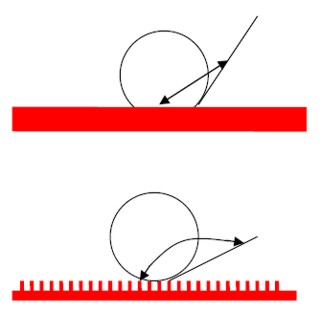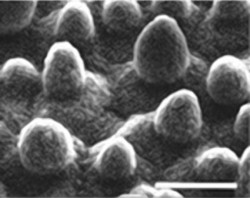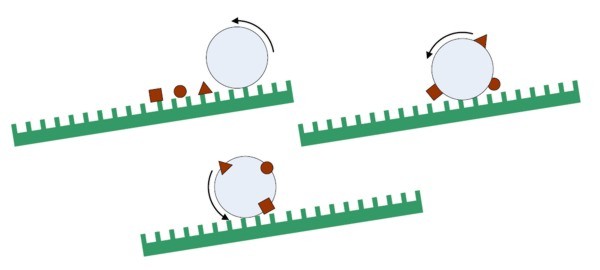|
Stick to me if you can
Ancient Chinese Confucian philosophers not only adored the beauty of the lotus flower they were astounded by the ability of the plant to grow out of mud without a trace of dirt attached to the leaves. Modern physicists may or may not be equally admiring of the lotus's loveliness, but they certainly fall in line behind the philosophers in their admiration of its amazing non-stick leaves. Years of effort were required by teams of unsung heroes to give us our Teflon frying pans and Gortex raincoats; lotus plants discovered the secrets of super-non-wettability millions of years ago. I retract that remark (as you no doubt guessed I would). The Supreme First Cause (aka God) drafted these secrets in His infinitely powerful mind long before He crafted the lovely lotus.
Anybody who has watered garden plants knows that water sticks to some leaves and rolls right off some others. Since many scientific applications are critically tied to the wettability or otherwise of various surfaces the secrets of surface wettability have been exposed to untold billions of hours of study. As is often the case (see "Biomimetics and intelligent design"), nature has provided countless models to study. As a believer in creation would guess, the phenomenon of non-stickiness is most definitely not a case of "one size fits all". For instance, some slick surfaces in nature rely primarily on smoothness to provide the lion's share of their hydrophobia (technical term for non-wettability), while others depend largely on some hydrophobic chemical coating. Believe it or not, the most powerful water-repellant surfaces in nature, such as the lotus leaf, are actually rough at the microscopic level.
The lotus leaf stands out as the unwettable natural surface par excellence, giving rise to the self-explanatory term "the Lotus effect". In this case, the properties of the leaf are of such a nature that the leaf not only shows itself thoroughly unfriendly to water but it also harnesses the phenomenon to cleanse itself of all dirt in the process.
When a droplet of water comes in contact with any surface, the degree to which the droplet either flattens and spreads out or, contrarily, rolls up into a little ball is governed by the properties of the leaf. When a droplet spreads out and makes a large surface of contact with the leaf it sticks. The more perfectly spherical the droplet, the smaller is the area that is in contact with the surface and the more readily it is repelled. Scientists describe this balling effect in terms of "contact angle" (see Fig. 1). Surfaces that produce a contact angle of over 150° are known as superhydrophobic. Lotus leaves produce a contact angle of almost 180°.
Readers with a technical bent could spend an entire lifetime or more studying the physics of wettability. Treatises on the topic are laced with mathematical equations and speak, for example, of Wenzel's and Cassie's models of the effects of roughness on the
|

Fig. 1: Top picture illustrates a drop of liquid on a fairly non-stick, smooth surface with a contact angle a little greater than 90°. Bottom picture shows a superhydrophobic, rough surface with a contact angle greater than 150°. Lotus leaf surface conditions create a contact angle of almost 180°.
interaction between a solid and water. The rest of us must be content with the attempts of experts to translate highly technical data into digestible concepts. One article tells us that,
The secret of the Lotus leaf can be found in numerous tiny pillars with a wax layer on top. Water drops are lifted by these pillars, get into a spherical shape and can simply not cover the surface. Dirt gets no chance to stick to the surface via water. The spherical drops roll off and take dirt particles with them.
That's probably about as technical as we should get here. If you want more, please see the links in the right hand column. But we can't quit without briefly discussing another side of the lotus leaf mystery, one that has only recently yielded up its secrets. Here is the mystery:
People have observed that condensation forms every night on the lotus leaf. When they come back in the morning the water is gone and the leaf is dry.
Apparently, water that condenses out of the atmosphere in between the tiny pillars mentioned above is actually quite sticky. Yet inevitably, after a certain amount of it has built up in the cooler temperatures of night, the leaf suddenly "flicks" it away. Laboratory investigators discovered that if they put a leaf with some condensation on it on the woofer part of a speaker producing low frequency vibrations, at a certain critical size a droplet would become rapidly unstuck and would appear to launch itself from the leaf. Wow! Scientists realized that the real world is full of subtle vibrations emanating from all sorts of sources, perhaps even including the croaking of frogs or the vibrations produced by wind caressing the leaves themselves. Now as to why lotus leaves really need to remain desert dry in a moisture-laden climate. well, that's a question for another day.
|






